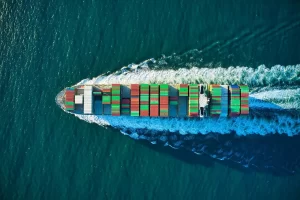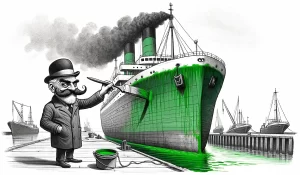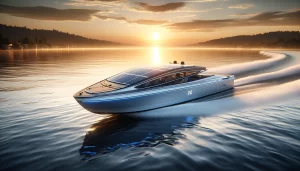Maritime decarbonization had a big year at COP27. For the unacquainted, every year the United Nations climate change conference, or more appropriately the Conference of the Parties (COP), brings together world leaders and thousands of others from across the world’s governments, businesses, and non-governmental organizations to talk about climate change issues. Given the high-visibility and international stage, this is a wonderful venue for organizations and institutions to launch new products, business offerings, and initiatives.
This past November, COP27 was held in Sharm el-Sheikh, Egypt. There were hundreds of announcements and honestly it was hard to keep track of everything announced during the weeks of the conference. Below is a summary of some of the maritime decarbonization announcements at COP27 that caught my attention. Note that a lot of these announcements were part of the Green Shipping Challenge which launched during the Climate Leaders Summit at the beginning of COP27 by the U.S. and Norway.
I’ve broken these COP announcements up into categories for ease of skimming:
Note that this list isn’t exhaustive, but it is comprehensive. If you think it’s missing something, let me know.
If you found value in this article, please click some ads, it helps me keep the lights on and it doesn’t cost you a thing.
Green Shipping Corridors
- What: The Zero-Emission Shipping Mission developed the Green Corridor Hub to serve as an interactive platform and toolkit to support the development of green shipping corridors. It hosts three resources, a route tracker, a matchmaker tool to connect stakeholders, and a curated library on green corridor reports.
- Why it Matters: Clearly there is a lot going on, so it’s hard to keep track of all the various efforts and initiatives. This Hub is meant to be a one stop shop for green shipping corridor information that allows users to easily identify routes, partners, and the latest intel on corridor formation or analyses.
Republic of Korea and the United States are Collaborating on Green Shipping Corridors
- What: During the World Leaders Summit of COP27, the Republic of Korea and the United States announced technical cooperation to facilitate the establishment of a green shipping corridor between major cargo ports within. The effort will begin with a feasibility study to explore a green shipping corridor’s potential between major cargo ports in the Republic of Korea and the United States.
- Why it Matters: Green shipping corridors can fast track infrastructure development by focusing attention on a single route. This potential route between Busan in South Korea and Tacoma, Washington in the United States could add to the growing list of green corridors under development that will drive adoption of zero-emission fuels for maritime transport.
Blue Sky Maritime Coalition (BSMC) and American Bureau of Shipping (ABS) Launch a Gulf of Mexico Green Shipping Corridor
- What: BSMC and ABS are working with the Ports of Houston and New Orleans, and others to establish a green shipping corridor in the Gulf of Mexico, that extends from Houston to New Orleans and up the lower end of the Mississippi River.
- Why it Matters: The US Gulf of Mexico is the heart of the oil and gas industry. This will be an interesting corridor to observe with regards to fuel choices and ultimately the feedstocks that are used. In an area that is flush with cheap oil, there may be strong temptations to adopt alternative fuels that use petroleum based feedstocks instead of cleaner options.
- What: The Port of Los Angeles, MPA Singapore, Port of Long Beach and C40 Cities have begun discussions to establish a green & digital shipping corridor that will help to facilitate the movement of cargo between Singapore and Los Angeles/Long Beach. The focus will be on: (i) low and zero carbon fuels and bunkering, and (ii) digital shipping and efficiency to support deployment of low and zero carbon ships.
- Why it Matters: Los Angeles and Long Beach are already involved in a different green corridor effort with Shanghai, China. This new announcement with Singapore capitalizes prior efforts, and could establish Los Angeles and Long Beach as an international hub for low-carbon fuels if these efforts pan out.
Australia-Singapore Announce Cooperation on Green Shipping Corridors
- What: Australia signed a first-of-its-kind Green Economy Agreement with Singapore, which includes a specific initiative to cooperate on efforts to accelerate implementation and promotion of technologies for decarbonising shipping. This initiative aims to establish the business / government / research partnerships required to implement green shipping corridors as a tangible outcome of technology development, deployment, assessment and information sharing. This adds to a $30 million Australian–Singapore partnership to accelerate the deployment of low emissions fuels and technologies like clean hydrogen to reduce emissions in maritime and port operations.
- Why it Matters: Country partnerships are important to decarbonize ocean transport as it is inherently international business. This is similar to the project between the U.S. and Korea noted above, but hopefully it can add to the list of new green corridors using low-carbon fuels. Australia is already engaged in a different effort to establish an iron ore route with Asia.
- What: The Green Shipping Corridors pre-feasibility blueprint prepared by the Mærsk Mc-Kinney Møller Center for Zero Carbon Shipping and Rocky Mountain Institute, under the Green Hydrogen Catapult, is a guide for project stakeholders interested in understanding the green corridor options in a given port, region, country or sub-continent. The blueprint offers a data-driven approach whereby an area is screened with respect to specific selection criteria, and a suite of green corridor options are outlined. The approach applies seven logical steps needed to cover a holistic value-chain assessment of opportunities for green corridors.
- Why it Matters: There is a lot of interest in forming green shipping corridors, but not a clear process on how to do it. Almost certainly the process will vary depending on geography and stakeholders involved, but this document can help speed up the process and give a sense of questions to ask, stakeholders to engage, and potential steps to follow. As we learn more, it will get better with time. Note that this builds on the previously published Feasibility Blueprint.
Saint Lawrence Seaway System Green Shipping Corridor Network Initiative
- What: The U.S. Department of Transportation, U.S. Department of State, and Transport Canada will work with state, provincial, local, private-sector, non-governmental leaders, and Indigenous Peoples in Canada and the United States to host consultations with ports and other stakeholders, with the goal of facilitating the establishment of a green corridor network within the Great Lakes region.
- Why it Matters: The Great Lakes may not be top of mind when you think about maritime transport, but this is a critical maritime route. In fact, the ships that ply these waters consumed more than 500,000 tonnes of fuel in 2019 and that led to approximately 1.6 million tonnes (Mt) of CO2 emissions, about two-thirds of which were emitted in U.S. waters according to the ICCT. The ships within this region are older than average, due to the less corrosive effects of saltwater, which means they are far from the most efficient when it comes to fuel use.
The U.S. Department of State Launches the Green Shipping Corridors Initiation Project with $1.5 million
- What: This funding will be used to support feasibility studies for green shipping corridors involving developing countries. In addition, the United States and its partners in the Zero-Emission Shipping Mission are announcing the launch of a Green Shipping Corridor Hub, an online platform with resources and tools that aim to streamline the formation and deployment of green shipping corridors globally. The Hub will feature a green shipping corridor route tracker, a matchmaker tool to help stakeholders connect, and a library of green shipping corridor reports and analyses.
- Why it Matters: I was genuinely enheartened to see this maritime decarbonization announcement at COP27. Many of the green shipping corridors announced to-date are in major economies, but we can’t forget about small island developing states (SIDs) or other smaller economies. These nations are particularly reliant on maritime transport, and are often the ones feeling the brunt of climate change.
- What: The Getting to Zero coalition and Global Maritime Forum published the report as a follow-on to the Clydebank Declaration, which identifies more than 20 green corridor initiatives across Transpacific, Asia Pacific and Transatlantic regions, Europe, North and South America.
- Why it Matters: As you are likely realizing, there are a lot of green corridor efforts underway and it’s hard to keep track of everything. The Green Shipping Corridor Hub, from the Zero-Emission Shipping Mission, can help with real time monitoring, but annual reports like this are great for stepping back and seeing how we’ve changed the sector. Looking forward to many more of these to come.
- What: Not a lot of details on this at the moment, but this group will be focused on bringing together experts in the sector, encouraging vital research and development, and driving other important work and projects to see these initiatives come to life as quickly as possible.
- Why it Matters: This group will streamline international collaboration specifically on corridor formation. The UK is within the top ten import/export countries for the US as of 2017, so any routes established between these two countries could move the needle on emissions reductions. This group can also likely support other countries that want to get engaged but don’t know how.
Policy and Coalitions
- What: The Administration proposing the Federal Supplier Climate Risks and Resilience Rule be included in the Federal Acquisition Regulations, which would require major Federal contractors to publicly disclose their greenhouse gas emissions and climate-related financial risks and set science-based emissions reduction targets.
- Why it Matters: This isn’t a maritime decarbonization announcement per se, but it could have huge ramifications on the industry in the US. Under the proposed rule, the largest suppliers including Federal contractors receiving more than $50 million in annual contracts would be required to publicly disclose Scope 1 and 2, and relevant categories of Scope 3 emissions disclose climate-related financial risks, and set science-based emissions reduction targets. Of course, maritime activities can be a large portion of emissions for many supply chains, so it will be interesting to see if this new rule comes into effect. If you have opinions on the matter, get them into the public comment process here.
- What: The Cargo Owners for Zero Emission Vessels (coZEV) initiative led by Aspen Institute was founded in 2020. This new Roadmap from the group presents new action areas for cargo owners seeking to accelerate deployment of zero emission shipping, engage in maritime decarbonization policy, and support green shipping corridors. The Roadmap also calls for the establishment of a Zero Emission Maritime Buyers Alliance (ZEMBA).
- Why it Matters: Cargo owners use ocean carriers to move their product overseas. As individual companies they may be limited in their influence, but as a group, they can wield massive influence on ocean carriers by placing their cargo on certain vessels, thereby influencing behavior. ZEMBA may be a useful forcing function.
- What: In early 2023, the U.S. Department of Energy, the Department of Transportation, the Environmental Protection Agency, and the Department of Housing and Urban Development will release a transportation sector decarbonization blueprint, which will serve as a roadmap for expanding federal agency priorities to create options for traveling smarter, more efficiently, and cleaner. After the release of the blueprint, these departments and agencies will start on the development of a U.S. maritime decarbonization strategy, which will identify the pathways for—and the agency-specific actions that can support—decarbonization of the domestic maritime sector.
- Why it Matters: As Lewis Carroll famously wrote, “if you don’t know where you are going, any road will get you there.” There are myriad technologies and fuels that could help decarbonize the maritime sector, some more mature then others. Prioritizing US government spending and policy on those that can have the biggest impact is absolutely essential.
- What: Known as the France-Mer 2030 plan, it budgets €300 million over five years to accelerate the financing of zero-emission ships. “The funding will be dedicated toward maritime innovation with the ultimate goal being the development of a zero-emission vessel design.”
- Why it Matters: This is a nice chunk of change for maritime decarbonization, but we need much more! Keep in mind that €300 million is enough to buy a few containerships. Every little bit of government funding and financing can help though, and perhaps more importantly, it can send positive signals to other private investors to join the fray.
Research and Demonstration
Collaboration on Cargo Vessel Powered by Green Ammonia
- What: Green NortH2 Energy, Meriaura, and Wärtsilä have expressed intent to build a cargo vessel that runs on green ammonia. The vessel will be ordered and operated by Meriaura. The delivery of the vessel, equipped with Wärtsilä’s modular multifuel main engines, is targeted for 2024.
- Why it Matters: Ammonia might be a viable low-cabron alternative to heavy fuel oil, but we need to get more demonstration vessels out on the water showing what’s possible. This can build more confidence in alternative fuels.
Germany allocates €30 Million per year for Climate Neutral Ships
- What: Green NortH2 Energy, Meriaura, and Wärtsilä have expressed intent to build a cargo vessel that runs on green ammonia. The vessel will be ordered and operated by Meriaura. The delivery of the vessel, equipped with Wärtsilä’s modular multifuel main engines, is targeted for 2024.
- Why it Matters: Ammonia might be a viable low-cabron alternative to heavy fuel oil, but we need to get more demonstration vessels out on the water showing what’s possible. This can build more confidence in alternative fuels.
Germany DLR Institute for Maritime Energy Systems Funding Zero-Emission Research Vessel
- What: The DLR Institute is spending €36 million to build a zero-emission research vessel to test and develop modular energy and ship concepts. This allows new testing capabilities,concept development and validation, and ensures the reliability of low- and zero-emission solutions.
- Why it Matters: Demonstration vessels are needed to prove viability of concepts and de-risk technologies and fuels so we can step-up private investment. Low-risk equates to safer investment, but to lower the risk of a technology requires operational data and proof that it operates as intended.




